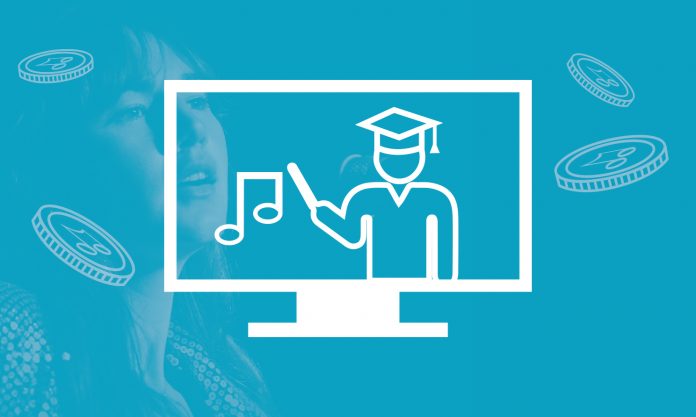*Your language will be set using a browser cookie.
Note: We have temporarily disabled login via Facebook.
If you use this service to log in, simply reset your password here: password reset form.
After resetting you will be able to login with the email address and new password.
Don’t have an account? Sign up
Forgot your password?
The Organisation for Economic Cooperation and Development (OECD) has noted a substantial rise in online learning in the wake of the COVID-19 pandemic.[1] Online course platforms such as Udemy reported a 425% enrolment rise, with a 55% increase in course creation by instructors to meet surging demand.[2] And, though students around the world are heading back to physical classroom spaces, the growth in the e-learning industry shows no sign of slowing down, as people “continue to readjust to life in the pandemic economy … by [picking] up new skills as they look for ways to be productive.”[3]
In this article, we look at how South African musicians can take advantage of this boom in online learning, by creating online music courses and other e-learning products.
E-learning vs e-teaching
Before delving into the specifics, it is important to clarify that we are not discussing the ‘live’ teaching of music in this article – for example, giving Zoom or Skype music lessons. For a comprehensive rundown of teaching opportunities, including online teaching and tutoring gigs, please consult our article on teaching opportunities for South African musicians.
Rather, this article is focused on e-learning products, such as short courses, which you create and then sell on various online platforms for students to complete in their own time and at their own pace.
There have been many studies debating the relative advantages and drawbacks of online learning, but focusing the discussion through the lens of potential revenue streams reveals the following important considerations.[4]
Advantages of online course creation:
Disadvantages (especially compared to ‘regular teaching’) include:
Video: Udemy is the world’s largest e-learning platform, hosting more than 250 000 online courses.
Online music courses
To get a sense of the size and rate of expansion of the e-learning market, this industry has grown from $107 billion in 2015 to $250 billion in 2020,[6] and is expected to each $1 trillion by 2027.[7] In terms of sheer numbers and growing demand, this market is predicted to draw professionals from across all industries – including artists, such as musicians, looking for ways to diversify their sources of income in the context of the COVID-19 pandemic.
There are many excellent ‘how to’ resources available online, such as this one from the Balance Small Business and this one from eLearning Industry, both of which give helpful pointers about how to construct your course and market it effectively.
However, you should bear in mind the following all-important guidelines gleaned from academic research:[8]
In terms of which e-learning platform to use to sell your course, there are many options available to you. This City Press article provides a rundown of some of the most popular sites, as does this 2021 piece from Foundr.
Finally, note that – in addition to a course platform – you may require other channels to advertise your course effectively, such as a YouTube channel where you provide partial lessons for free, or a Patreon page where you paywall your e-learning content for an existing audience.
For instance, South African guitarist Billy Monama has partnered with Indigenous African Music, in addition to running a lesson-based YouTube channel, while Derek Gripper has a Patreon page that demonstrates an excellent example of how to paywall and tier e-learning content appropriately. Please consult our individual articles about YouTube, Patreon and other emerging social media platforms for more information.
Video: Billy Monama hosts a series of South African guitar tutorials on his YouTube channel.
Custom e-learning products
If making extensive online courses doesn’t appeal to you, then consider custom e-learning products, such as tabs, transcriptions or lessons that focus on a single song.
These can be added-value products to existing revenue streams, such as your website or YouTube channel,, and can promote fan engagement through the process of taking requests and sharing the method of learning/transcribing the song. For a successful example of this approach, see GuitarNick’s Patreon page or Marcel Ardans’ website.
As we can see from the Revenue Streams for Music Creators in South Africa 2022 report, the different online services mentioned in this article are beginning to provide real revenue opportunities for music creators.
The following figures are average monthly earnings:
Ilker Koksal, writing for Forbes magazine in 2020, declared: “It’s a fact that online learning is the future and will undoubtedly replace land-based learning in the future.”[11] Time will tell whether this prediction proves true or not, but, for now, the e-learning industry is undoubtedly a fast-growing space that could function as a supplementary revenue stream for South African musicians.
Resources and citations
This article is part of the Revenue Streams for African Musicians project, supported by UNESCO’s International Fund for Cultural Diversity in the framework of the UNESCO 2005 Convention on the Protection and Promotion of the Diversity of Cultural Expressions, the Siemens Cents4Sense programme, Siemens Stiftung, Goethe-Institut, the National Arts Council of South Africa and Kaya FM.
Editing by Kalin Pashaliev
Sponsored
See all
Disclaimer: Music In Africa provides a platform for musicians and contributors to embed music and videos solely for promotional purposes. If any track or video embedded on this platform violates any copyrights please inform us immediately and we will take it down. Please read our Terms of Use for more.






